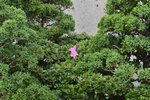Okay, I did some work for you. Actually, I save photos of good examples of trees, either bonsai, or nature, for inspiration.
Bonsai Bark, a blog worth subscribing to, posted by Wayne Schoech, of Stone Lantern Publishing. Back in 2014 he posted a series of posts on forest plantings. The link to his blog is here

stonelantern.com
I saved these photos from his 2014 posts about forests. These were taken at the Asheville NC Arboretum, the 2014 Carolina Expo. I believe these were all created by Arthur Joura, the bonsai collection curator. of the 5 forests, 4 are mixed species. If you zoom in, you might be able to read labels for species names. I did not make additional notes. If you search the Bonsai Bark Blog, you can find Wayne Schoech's original blog comments where he might have mentioned species, or an interview with Arthur, where he might have discussed species choices.
View attachment 320035
View attachment 320036
View attachment 320037
View attachment 320038
View attachment 320039
View attachment 320040
This last forest, if I remember correctly, was styled after a specific place. The junipers were chosen as stand ins for red spruce, or balsam fir, and the Azalea kiusianum was chosen as a stand in for the large leaf Rhododendron you see in the Appalachian Mountains.
Arthur Joura is famous for recreating Appalachian images in his bonsai. He tends toward naturalistic styles, much like Walter Pall does. You should make yourself familiar with his work.

www.bonsai-nbf.org










